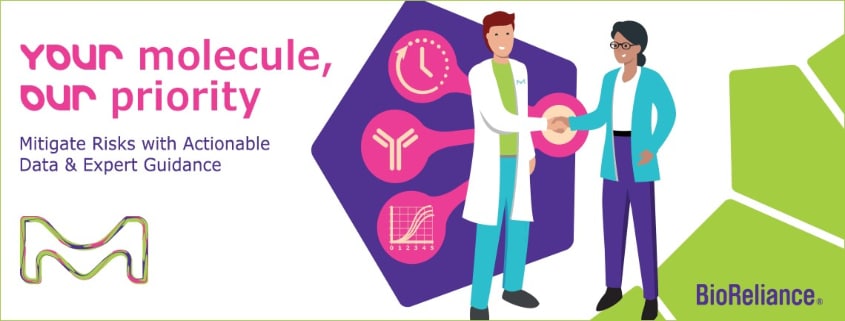Start Early
Developing and manufacturing a biopharmaceutical drug is a complex mission . Throughout development, teams working on drug candidates go through various phases of risk mitigation strategies. This encompasses simple risk assessments during development, to detailed Failure Modes and Effects Analysis (FMEA) during process validation.
One specific risk to become very familiar with is the risk of viral contamination of a production process. Viral contamination events during GMP production have occurred throughout history. These events are considered catastrophic and can cost millions of dollars in damage and disrupt crucial drug supply. Some of these contaminations were of known viruses and some were new viruses (i.e. Calicivirus) only discovered after the contamination occurred.
There are three key elements to virus risk mitigation, commonly known as the safety triangle. First, prevention of virus entering the production process, second, detection of viral contaminates during processing, and third the removal of viral contaminates from the process. These elements should be assessed from the very beginning of development including pre-Investigational New Drug (IND) application to Biologics Licensure Application (BLA) and after commercial license of a biopharmaceutical drug.
Prevention
The first key piece to virus risk mitigation is prevention. Preventing the access of a virus to the production process, encompasses several factors. These factors include raw material selection, raw material risk based on origin, and manufacturing components (i.e. stainless steel vs. single-use products).
Let’s focus on raw material selection and origin considerations. At the beginning stages of development, an assessment of raw materials to be used in the process should be made and evaluated as a best practice. For example, in Chinese Hamster Ovary (CHO)- based processes, most new production processes have removed animal-based medias and feeds (a source of known viral contaminants) and replaced them with animal-origin free components. In other production processes (e.g. cell and gene therapy), the removal of animal-based or human-based components such as fetal bovine serum (FBS), trypsin, or growth factors may not always be possible. These components carry a higher risk of virus contamination and need to be tested accordingly prior to use.
Implementing barrier technologies to either remove or inactivate viruses is strongly recommended. The common types are nanofiltration, high temperature, short time (HTST) treatment, and UV-C irradiation. Nanofiltration, such as 0.1µm sterilizing grade filter, is routinely used in the preparation of medias, feeds, and other components. Flash pasteurization (HTST) has been shown to inactivate viruses and should be considered to help safeguard production processes. UV-C, while still relatively new in the biopharmaceutical space, can be an effective step in the treatment of raw materials where applicable.
Detection
The second key piece to virus risk mitigation is the ability to detect a viral contaminant present in a production process and is performed at several steps in the process. Raw materials can be tested for viral contamination via in vitro and virus-specific polymerase change reaction (PCR) assays. The master cell bank and end-of-production cell bank are rigorously tested via cell culture-based methods, in vitro and in vivo, Transmission Election Microscopy (TEM), and PCR specific tests of viral contaminants. End of production bioreactor and bulk harvest are tested routinely by in vitro, TEM, and by virus specific PCR tests.
The assays performed (e.g. in vitro, in vivo) detect a broad range of known or potential unknown viruses based on utilizing cells or animals. Historically, PCR has been used for known viruses such as minute mice virus (MMV) for rodent cell lines and human immunodeficiency virus (HIV) for human cell lines.
The new Blazar™ platform from the BioReliance® portfolio, is a rapid molecular detection method that detects a broad range of virus contaminates with the speed of PCR. The Blazar™ platform utilizes PCR with degenerate primers to enable broad spectrum detection of virus families, including both known and potentially unknow viruses.
Next generation sequencing (NGS) is also becoming a widely accepted technology for the detection of viruses. Unlike traditional Sanger sequencing, NGS converts a sample into a sequencing-compatible DNA library, and upon sequencing generates millions to billions of individual reads. These are then analyzed using bioinformatics utilizing viral sequence databases to detect and identify virus contaminants.
Removal
The third and final key to virus risk mitigation is to understand the production processes’ ability to remove or inactivate viruses. The removal or inactivation of a potential viral contaminate can start with the bulk harvest drug substance and continue through the downstream purification process. Viral clearance studies are performed in both early stage pre-IND and late stage development. These studies are critical to mitigate risk of viruses being present in a drug product.
For early stage processes of a well-characterized cell line, typically two model viruses are used to show viral clearance. At this stage, it is recommended to test both an enveloped and non-enveloped virus at each applicable step. Viral clearance is achieved by either inactivation or removal of viruses from the production process. Showing inactivation is accomplished by utilizing low pH, solvent, and a detergent to disrupt enveloped viruses. Affinity, cation exchange, and or anion exchange chromatography are used to show removal of viruses from purification processes. A nanopore filtration (i.e.
During late stage development, a more comprehensive viral clearance study is performed on the locked down process. These studies incorporate more extensive testing with four or more model viruses, encompassing both enveloped and non-enveloped, DNA, and RNA viruses. This stage also assesses the chromatography resin and filter/membrane reuse, cleaning, virus carryover, and aged resin studies to gauge if the viral clearance is impacted by any of these factors.
In addition, it’s necessary to repeat of the viral clearance study to address any process changes. This is critical to demonstrate the effective clearance isn’t reduced by the change to the process.
Final Thoughts
Virus risk mitigation is a key aspect of any product development strategy. Whether a company is utilizing a traditional production process or new and emerging modalities such as cell and gene therapy products, to the ability to understand the viral risks and mitigation is critical to evaluate the potential impact on the biopharmaceutical production process and paramount to ensure patient safety.





